|
||||||||
Make your own Alcohol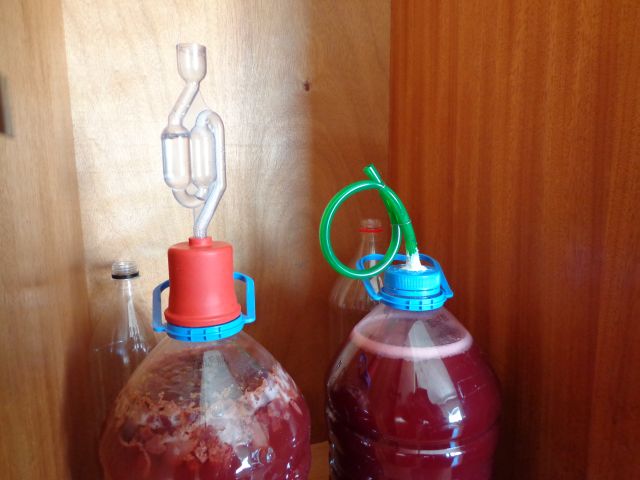
Produce delicious red wine at homeIn some countries like Saudi Arabia or Iran it is difficult to buy alcohol, because it is officially prohibited. Other countries like Turkey have such a high duty on alcohol, that alcoholic drinks are compared with other food for daily use extreme expensive up to totally unaffordable. But you can also save a lot of money in other countries, if you produce alcohol by yourself. Besides it makes fun and is exciting. IngredientsFor this you need just a few things: 4 liters grape juice from supermarket, 500-1000g blue grapes, 13 tablespoon sugar, 1/2 teaspoon baker's yeast or professional cultured yeast.
MaterialAs a first step you need a lockable 5-litre-container. For this you can use for example, as shown, a container for water from supermarket. Also a lockable canister from DIY superstore can be used. If you have enough money, you can order a professional container. The container has to be locked with a fermentation lock. For this you can order a professional one or make your own according to the following instructions with the container's lid, hose for aquarium, silicone lubricant and paper clips (or florists wire or rather a stable cord). For self-construction form the hose like shown on the photo and fix it with the paper clips' wire (or florist's wire or rather a stable cord), and finally seal it with silicone lubricant to become air tight.
PreparationDuring preparation higher ambient air temperatures between 68 and 77 degrees Fahrenheit (20 - 25 degrees Celsius) are very favorable; temperatures up to 95 degrees Fahrenheit (35 degrees Celsius) are tolerable. At ambient air temperatures less than 68 degrees Fahrenheit (20 degrees Celsius) the base can be a failure, if the yeast wasn't activated before given into the fermentation container. At first the 5-liter container has to be filled with 13 tablespoon sugar. Then two liters grape juice are added. Shake or stir the mixture for dissolving all sugar. Now a half teaspoon baker's yeast or professional cultured yeast has to be added. Afterwards the third liter grape juice is filled up. Shake or stir the mixture again. After that the grapes are removed from the rachis (the stem which holds the grapes), this is called destemming. In a bowl squeeze the berries and break the skins to start to liberate the contents of the berries. This mixture of fruit pulp, grape pips, skins and juice is called must. It is important, not to mash the pips, because in that case they will give a bad taste to the wine.
FermentationNow the fermentation vessel is positioned to the place, where it will remain fixed during next days. Finally, if the container has not to be moved any more, it is closed with a fermentation lock. The lock is filled with a syringe up to the marking (for a self-constructed have a look to the following movie) with water. Now the biochemical conversion of sugar to alcohol by yeast (single-celled microorganism) can start, what is called fermentation. These microorganisms start to be alive and active after dissolving the dried yeast in warm water. Red wine ferments optimal at temperatures from 72 to 77 degrees Fahrenheit (22 to 25 degrees Celsius) in the room, where the fermentation container is left for fermentation. Ambient air temperatures less than 68 degrees Fahrenheit (20 degrees Celsius) reduce fermentation process. This makes the wine fresher. Less than 59 degrees Fahrenheit (15 degrees Celsius) are too cold, other microorganisms like bacteria and mould can gain the upper hand and let the must rot - it becomes useless. Temperatures more than 77 degrees Fahrenheit (25 degrees Celsius) accelerate fermentation, but make the taste worse. Ambient air temperatures more than 90 degrees Fahrenheit (32 degrees Celsius) reduce fermentation process again, at 113 degrees Fahrenheit (45 degrees Celsius) ambient air temperature yeast begins to die. So avoid ambient air temperatures less than 59 degrees Fahrenheit (15 degrees Celsius) and more than 90 degrees Fahrenheit (32 degrees Celsius), temperatures between 68 and 81 degrees Fahrenheit (20 - 27 degrees Celsius) lead to a good result. Furthermore notice, light has a negative effect on wine; best solution is letting the wine ferment in total darkness. In addition take meticulous care the fermentation container is closed completely airtight. If oxygen can reach the grape must or wine, acetic acid bacteria covert alcohol to vinegar, this makes the wine unpalatable. Transfer
Secondary fermentation and agingActually wine isn't ready now, although "Junger Wein" can already be drunk. But result will taste better, if you put the wine again in a fermentation vessel and let it rest a few days or weeks, during which it can be transferred several times for activating biochemical reactions. While secondary fermentation sugar rests will be converted by remaining yeasts that you can find on the vessel's bottom later. Bottling
|
||||||||
|
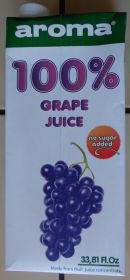
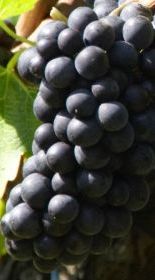
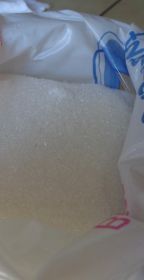
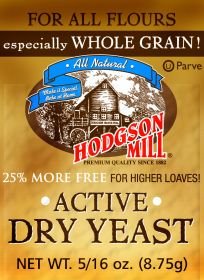
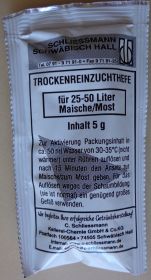
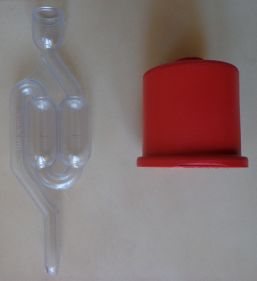
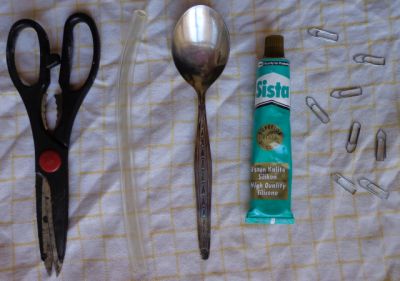
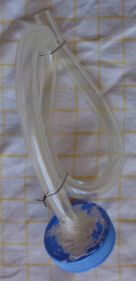
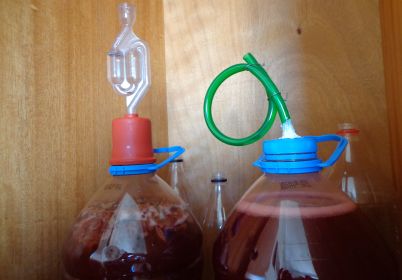 The
must is poured now into the container. Afterward the container is filled
up with the fourth liter grape juice, but leave enough space at the
top of the container for froth (look at the photo beside the text).
Depending on the amount of must, approximately a glass juice will remain.
If it's not possible to get grapes, also 4,5 liter grape juice can be
prepared, but then the wine will lose color and taste, only a drink
similar to wine can be created, how the grape juice's quality plays
an important role.
The
must is poured now into the container. Afterward the container is filled
up with the fourth liter grape juice, but leave enough space at the
top of the container for froth (look at the photo beside the text).
Depending on the amount of must, approximately a glass juice will remain.
If it's not possible to get grapes, also 4,5 liter grape juice can be
prepared, but then the wine will lose color and taste, only a drink
similar to wine can be created, how the grape juice's quality plays
an important role.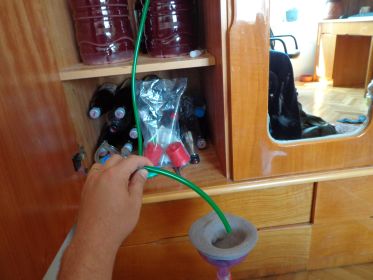 Depending
on the ambient air temperature main fermentation is finished after eight
to fourteen days. The higher ambient air temperature, the faster fermentation
is finished. After grape must started to ferment, wine becomes murky.
The end of fermentation can be recognized by liquid becoming clear again
and yeast sediment on the container's ground. After fermentation process
most wines reach between 8 and 13 percent alcohol. The must became a
"Junger Wein" (young wine), that can be drunk. If the wine tastes still
sweet, the fermentation hasn't finishes now; the wine should continue
to ferment. But it is also possible, to drink the wine before finishing
fermentation, than it is called "Neuer Wein" (new wine). To transfer
the wine into another container a hose (for example a hose for aquarium)
and a funnel should be used, because the container must not be moved,
otherwise the bad tasting yeast sediment from ground spreads out again
in the wine. The funnel should be lined with cloth for filtering
inadvertently sucked grape rests. For pouring the horse is placed on
the container's to below the swimming grape remains and then lowered,
until is stopped short before reaching yeast sediment on the ground.
The rest with yeast sediment is not used. It can be given to garbage
or can be drunken, if someone feels its taste as bearable. Unfortunately
the yeast cannot be filtered with a coffee filter, because the filter's
pores are too coarse.
Depending
on the ambient air temperature main fermentation is finished after eight
to fourteen days. The higher ambient air temperature, the faster fermentation
is finished. After grape must started to ferment, wine becomes murky.
The end of fermentation can be recognized by liquid becoming clear again
and yeast sediment on the container's ground. After fermentation process
most wines reach between 8 and 13 percent alcohol. The must became a
"Junger Wein" (young wine), that can be drunk. If the wine tastes still
sweet, the fermentation hasn't finishes now; the wine should continue
to ferment. But it is also possible, to drink the wine before finishing
fermentation, than it is called "Neuer Wein" (new wine). To transfer
the wine into another container a hose (for example a hose for aquarium)
and a funnel should be used, because the container must not be moved,
otherwise the bad tasting yeast sediment from ground spreads out again
in the wine. The funnel should be lined with cloth for filtering
inadvertently sucked grape rests. For pouring the horse is placed on
the container's to below the swimming grape remains and then lowered,
until is stopped short before reaching yeast sediment on the ground.
The rest with yeast sediment is not used. It can be given to garbage
or can be drunken, if someone feels its taste as bearable. Unfortunately
the yeast cannot be filtered with a coffee filter, because the filter's
pores are too coarse.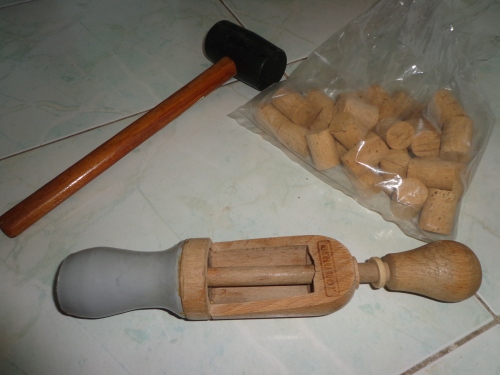 After wine has been tranferred wine one or two times
it can be filled to bottles. The bottles should be colored green or
brown to protect wine from too much incidence of light. Most easy
to handle are plastic bottles. They can be cleaned well and they are
light and stable. Or you can fill wine to real wine bottles or
be corked by a corking machine if they are without screw top.
After wine has been tranferred wine one or two times
it can be filled to bottles. The bottles should be colored green or
brown to protect wine from too much incidence of light. Most easy
to handle are plastic bottles. They can be cleaned well and they are
light and stable. Or you can fill wine to real wine bottles or
be corked by a corking machine if they are without screw top.